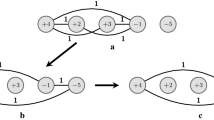Abstract.
Sorting permutations by operations such as reversals and block-moves has received much interest because of its applications in the study of genome rearrangements and in the design of interconnection networks. A short block-move is an operation on a permutation that moves an element at most two positions away from its original position. This paper investigates the problem of finding a minimum-length sorting sequence of short block-moves for a given permutation. A 4/3 -approximation algorithm for this problem is presented. Woven double-strip permutations are defined and a polynomial-time algorithm for this class of permutations is devised that employs graph matching techniques. A linear-time maximum matching algorithm for a special class of grid graphs improves the time complexity of the algorithm for woven double-strip permutations.
Similar content being viewed by others
Explore related subjects
Discover the latest articles and news from researchers in related subjects, suggested using machine learning.Author information
Authors and Affiliations
Additional information
Received June 1, 1997; revised July 25, 1998.
Rights and permissions
About this article
Cite this article
Heath, L., Vergara, J. Sorting by Short Block-Moves. Algorithmica 28, 323–352 (2000). https://doi.org/10.1007/s004530010041
Issue Date:
DOI: https://doi.org/10.1007/s004530010041




